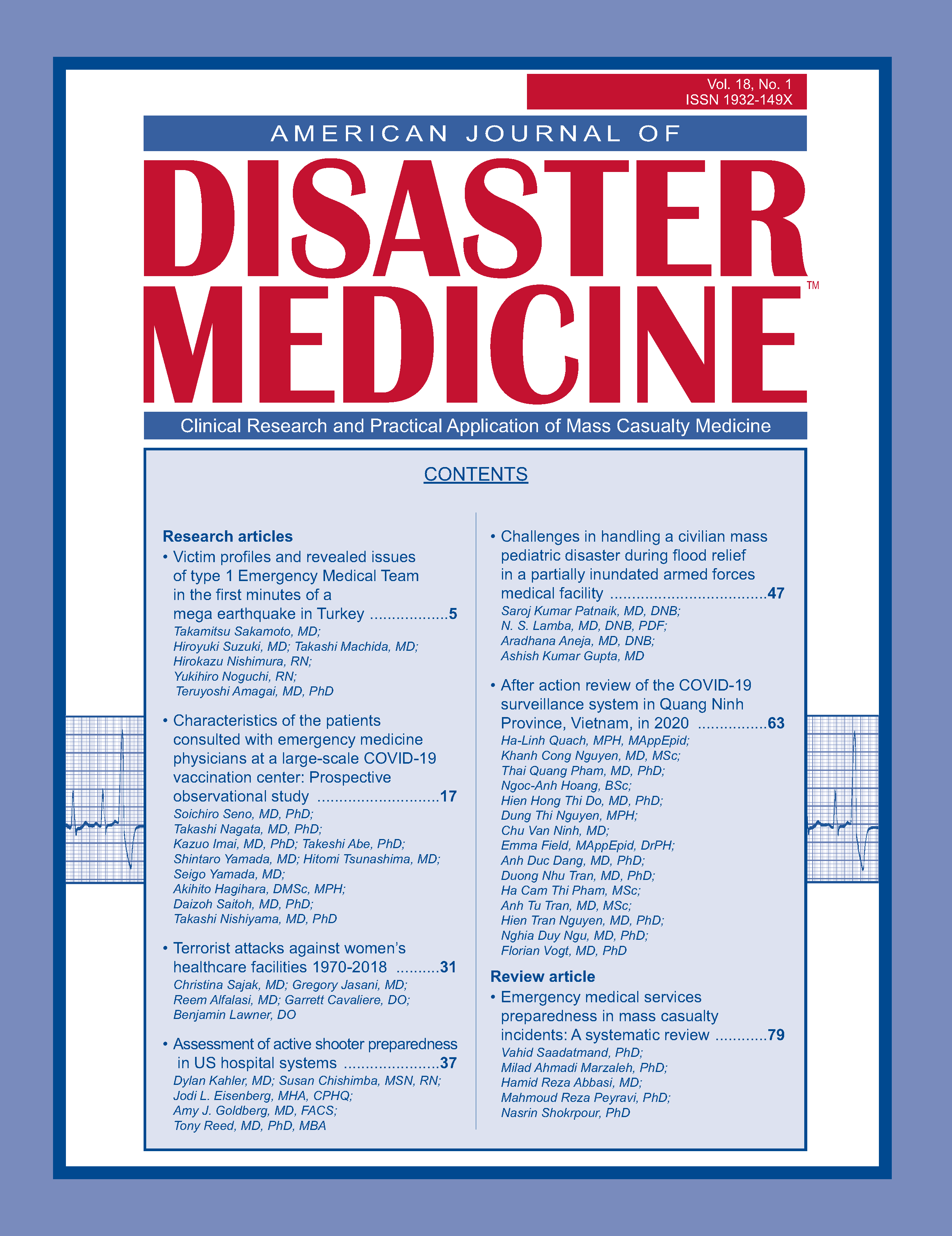Emergency medical services preparedness in mass casualty incidents: A systematic review
DOI:
https://doi.org/10.5055/ajdm.0461Keywords:
emergency medical services, disaster, mass casualty incident, emergency preparednessAbstract
Objective: The role of emergency medical services (EMS) preparedness in mass casualty incidents (MCIs) is crucial. MCIs are increasing worldwide, and EMS must enhance preparedness for them. For this purpose, the main components of EMS preparedness should be identified. This study aimed to describe the components of EMS preparedness in response to MCIs.
Design and setting: This systematic review was conducted based on the Preferred Reporting Item for Systematic Reviews and Meta-analyses guideline. The articles published from January 1970 to February 2022 were searched to discover the main components of EMS preparedness in MCIs. The electronic databases including PubMed, Cochrane Library, Scopus, Science Direct, and ProQuest were searched using predetermined keywords. Ten articles were selected and included in this review.
Results: After reviewing the articles, we identified the components of EMS preparedness in MCIs. Accordingly, 16 main components were extracted and classified into four categories, ie, individual improvement, group improvement, resources, and operations.
Conclusion: MCIs are so complicated that they require adequate prehospital preparedness. This study described the components of EMS preparedness in MCIs. The authorities in EMS will benefit from this framework in planning and responding to MCIs.
References
Sadat SJ, Afrasiabifar A, Khorasani-Zavarehg D, et al.: Exploring barriers and facilitators of inter-organizational management in response to mass casualty traffic incidents: A qualitative study. Bull Emerg Trauma. 2021; 9(2): 86-95.
Sauerborn R, Ebi K: Climate change and natural disasters integrating science and practice to protect health. Glob Health Action. 2012; 5: 19295.
Centre for Research on the Epidemiology of Disasters: UN office for disaster risk reduction. 2020. The non-COVID year in disasters global trends and perspectives. Brussels. 2021. Available at https://www.emdat.be/non-covid-year-disasters-global-trends-and-perspectives-0. Accessed November 9, 2022.
Gabbe BJ, Veitch W, Mather A, et al.: Review of the requirements for effective mass casualty preparedness for trauma systems. A disaster waiting to happen? Br J Anaesth. 2022; 128(2): E158-E167.
Beyramijam M, Farrokhi M, Ebadi A, et al.: Disaster preparedness in emergency medical service agencies: A systematic review. J Educ Health Promot. 2021; 10: 258.
Jadidi A, Irannejad B, Bahrami P, et al.: Is emergency medical services (EMS) in Islamic Republic of Iran practical and efficient in facing Ebola? BEAT. 2019; 7(3): 315-319.
Saberian P, Kolivand PH, Hasani-Sharamin P, et al.: Iranian emergency medical service response in disaster: Report of three earthquakes. Adv J Emerg Med. 2019; 3(2): E13.
Holgersson A, Eklund A: Emergency medical response in mass casualty tunnel incidents with emphasis on pre-hospital care. J Hum Secur. 2020; 16(1): 3-15.
UNO: Framework for disaster risk reduction 2015–2030, UNDRR. Geneva, Switzerland. 2015. Available at https://www.unisdr.org/files/43291_sendaiframeworkfordrren.pdf. Accessed November 9, 2022.
Heemskerk JL, Abode-Iyamah KO, Quinones-Hinojosa A, et al.: Pre-hospital response time of the emergency medical service during mass casualty incidents and the effect of triage: A retrospectives. Disaster Med Public Health Prep. 2022; 16: 1091-1098.
Hugelius K, Edelbring S, Blomberg K: Pre-hospital major incident management: How do training and real-life situations relate? A qualitative study. BMJ Open. 2021; 11: e048792.
Fattah S, Rehn M, Lockey D, et al.: A consensus-based template for reporting of pre-hospital major incident medical management. Scand J Trauma Resusc Emerg Med. 2014; 22: 5.
Hardy S, Fattah S, Wisborg T, et al.: Systematic reporting to improve the emergency medical response to major incidents: A pilot study. BMC Emerg Med. 2018; 18(1): 4.
Dasgupta S, French S, Williams-Johnson J, et al.: EMS response to an airliner crash. Prehosp Disaster Med. 2012; 27(3): 299-302.
Brandrud AS, Bretthauer M, Brattebø G, et al.: Local emergency medical response after a terrorist attack in Norway: A qualitative study. BMJ Qual Saf. 2017; 26(10): 806-816.
Klassen AB, Marshall M, Dai M, et al.: Emergency medical services response to mass shooting and active shooter incidents, United States, 2014-2015. Prehosp Emerg Care. 2019; 23(2): 159-166.
Hansen PM, Jepsen SB, Mikkelsen S, et al.: The great belt train accident: The emergency medical services response. Scand J Trauma Resusc Emerg Med. 2021; 29(1): 140.
Mulvey JM, Shaw BH, Betzner M, et al.: Columbia icefield bus rollover: A case study of wilderness mass casualty triage, treatment, and transport. Prehosp Emerg Care. 2021; 26: 608-616.
Peyravi M, Khodakarim S, Örtenwall P, et al.: Does temporary location of ambulances (“fluid deployment”) affect response times and patient outcome? Int J Emerg Med. 2015; 8(1): 37.
Jama TJ, Kuisma MJ: Preparedness of Finnish emergency medical services for chemical emergencies. Prehosp Disaster Med. 2016; 31(4): 392-396.
Published
How to Cite
Issue
Section
License
Copyright 2007-2025, Weston Medical Publishing, LLC and American Journal of Disaster Medicine. All Rights Reserved.


